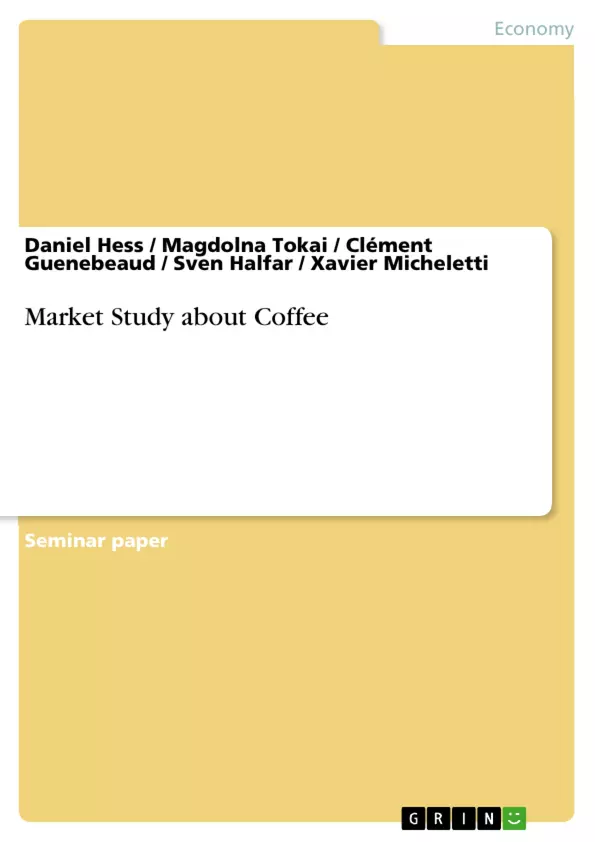Our challenge was to introduce a coffee brand into the Hungarian Market called “all
continents”. This coffee is for a young target group who like experience connected with a
Hungarian image. During our research the following question: Will this launch succeed
in the market that we have chosen?
Therefore, we focused on the existing Hungarian coffee market; it`s consumers, drinking
habits and competitors. To study this we used secondary research, a focus group
interview and prepared a questionnaire.
Firstly, we focused on the consumers. Coffee is a popular product and very frequently
consumed in Hungary. The overall consumption of coffee is increasing as well,
especially young people tend to buy more coffee. Furthermore, the consumption of this
group is still growing.
Secondly, we looked at the drinking habits. Our target group especially liked mixtures
and there is willingness in their attitude towards trying new things. Also, they use coffee
not only for the functional reason to wake up, but also for social reasons and having fun.
Thirdly, we have looked at our competitors. Nescafe represents the spirit of youth by
offering specialties. Segafredo is well known for its dynamism and strength. Tchibo is
the brand that is lively and well known worldwide. Jacobs stands for the harmony of with
variety of flavors. Douwe Egberts has a static image. Omnia is the virtue but is also less
dynamic. Julius Meinl represents just quality but in a static way.
Now we will try to give advise for the launch. There are good reasons, why the
introduction of “all continents” could be successful.
As we just explained, that young people are an important, increasing target group and the
drinking habits are on the way to change, or are already changing. People want to try new
things and drink coffee for a variety of reasons. Furthermore, we see a lack in the
positioning image of the existing competitors. Nescafe is for young, experiential people,
but it is not Hungarian. Brands with a Hungarian image are Douwe Egberts and Omnia.
But their images have gone out of fashion and our target group did not like them. In
conclusion, there is no brand, which has the image of a Hungarian brand for young,
experiential people.
In addition to our research we recommend to consider the analyze of the three remaining
P´s: price, place and promotion.
Table of Contents
- Executive Summary
- Problem Definition
- Research Design
- Primary Data
- Secondary Data.
- Sampling and fieldwork.
- Analyzing the Coffee Market in Hungary
- Development of the Coffee Market Over Time.
- The Consumers
- The Brands.
- Focus group interview
- Drinking habits
- The brand party of the middle ages.
- The innovative game....
- What would make you try a new coffee brand?
- Questionnaire
- Pre-test Arrangement
- Results of the Pre-test
- Timing and Budgeting
- Limitations
Objectives and Key Themes
The objective of this study is to assess the potential success of launching a new coffee brand, "all continents," in the Hungarian market. The brand is targeted towards a young audience who seek unique experiences and value a Hungarian identity. The research focuses on understanding the existing Hungarian coffee market, including consumer demographics, drinking habits, and the competitive landscape.
- The current state of the Hungarian coffee market
- Consumer preferences and drinking habits in Hungary
- Analysis of existing coffee brands and their positioning in the market
- Identifying opportunities for a new coffee brand based on consumer needs and market gaps
- Evaluating the potential success of launching "all continents" in the Hungarian market
Chapter Summaries
- Executive Summary: Provides an overview of the research project and its objectives, highlighting the key findings regarding the Hungarian coffee market and the potential success of launching "all continents."
- Problem Definition: Introduces the challenge of launching "all continents" in the Hungarian market and outlines the research questions that will guide the investigation. The brand's unique concept and target audience are described.
- Research Design: Details the methodology used to gather data, including primary research through focus group interviews and questionnaires, and secondary research using existing market data.
- Analyzing the Coffee Market in Hungary: Analyzes the development of the coffee market in Hungary, examines consumer preferences, and provides an overview of key competitors and their brand positioning.
- Focus group interview: Presents insights from a focus group discussion on consumer drinking habits, brand perceptions, and factors that influence their coffee choices.
- Questionnaire: Summarizes the pre-testing process and initial findings from a questionnaire designed to gather further data on consumer preferences and attitudes towards coffee.
- Timing and Budgeting: Discusses the timeline and budget considerations for launching "all continents" in the Hungarian market.
- Limitations: Identifies the limitations of the study, including sample size and the scope of the research.
Keywords
The key words and focus topics of this study include the Hungarian coffee market, consumer behavior, brand positioning, market research, focus group interviews, questionnaires, competitive analysis, new product launch, target audience, brand image, and "all continents" coffee.
- Arbeit zitieren
- Daniel Hess (Autor:in), Magdolna Tokai (Autor:in), Clément Guenebeaud (Autor:in), Sven Halfar (Autor:in), Xavier Micheletti (Autor:in), 2003, Market Study about Coffee, München, GRIN Verlag, https://www.grin.com/document/27090



